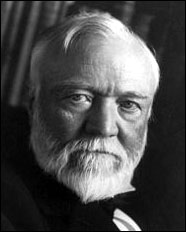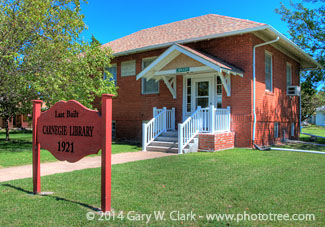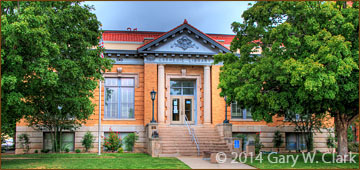
The Google of 100 Years Ago
We have virtually all the information, facts, history, and literature from the beginning of recorded time at our fingertips. We truly live in a golden era of knowledge.
in the 19th century, our ancestors weren't so fortunate. Of course all the electronic media was not available, but even sources of the written words were difficult to reach.
Libraries were the privilege of those in large cities or access to universities. However, one of the richest men in the world at the time started a simple program, though costly, to make the great and small literary works available to even small towns.
Andrew Carnegie (1835 - 1919)
| Carnegie was a successful industrialist, his primary wealth derived from the steel industry. He rode the industrial revolution of the late 19th century and the westward rail expansion to great fortunes. He was considered one of the riches men in the world, with his company eventually becoming the U.S. Steel Corporation. |
 |
Many wonderful stories, articles and books have been written about him, I will try to briefly summarize how his love of books impacted our ancestors, and in turn each of us. In addition, some observations not readily found elsewhere will be shared.
This short article concentrates on the libraries and thousands of grants in the early 20th century, his philanthropic legacy lives in the The Carnegie Corporation today.
Library Grant Concept
The Carnegie Corporation upon application by a city or town would grant a sizable amount of money towards the construction of a library. A few conditions were required, but no personal or political strings were attached. The applicant town must provide a clear-title to the building's land and budget annually 10% of the cost of the building for maintenance.
The city or town could add funds to the grant to increase the size of the building, add features, or include architectural and artistic characteristics. Thus, Carnegie funded libraries can be found as small simple buildings such as the Canton, Kansas library to more elaborate pieces of architecture. The grants usually were funded in the amounts of $10,00 to $20,000 ranges.
The Corporation also granted funds to universities and colleges to build academic libraries, which many are still in place.

Canton, Kansas - One of the smallest and last Carnegie public libraries built in 1921 with a grant of $6,000. (Click for larger image)
Impact on America
Many of these libraries gave our ancestors their first glimpse of the world outside their reach. Some of the libraries functioned as the local school library also, as the school district may not have afforded a library. Ask your relatives if they used a Carnegie Library. |
Carnegie Philosophy
Andrew Carnegie was not in love with books just for their intrinsic value. He felt that education and knowledge would propel people and societies to do great things. He and his architect provided communities with many choices of building plans from which to choose.

Wellington, Kansas Carnegie Library (Click for Large View)
All the designs included staircases into the building, some grand some simple, which was a metaphor for personal growth or reaching lofty goals. Communities did not have to use any of his designs and plans, but it was another way for them to reduce costs.
Factoids
| First U.S. Public Library Grant |
1889* |
| Last U.S. Public Library Grant |
1921* |
| Number of U.S. Public Libraries |
1.687** |
| Number of Academic Libraries |
108 |
| Total No. U.S. Public Grants |
1,419 |
| Total Dollars Granted |
$45.8 Million |
* Construction began or completed.
** The number of grants and built libraries varies with from different sources, and how multiple grants or buildings were accounted for.
Data from: List of Carnegie libraries in the United States, Wikipedia. Last accessed 10/14/14
Value of Grants
Over the life of the library grant program, The Carnegie Corporation provided over $45 million dollars to cities and towns across the U.S. and world. Economists use various formulas to calculate a present value of past dollar amounts. In today's dollar value, an online worth measuring tool shows the value of his contribution to be over one trillion dollars using a simple Consumer Price Index (CPI) formula. http://www.measuringworth.com/uscompare/.
(Note: This author uses the above worth calculator for historical research in determining costs of old photographs in today's terms, and in genealogical research to determine a families economic conditions by converting sales prices of land, bill of sale and inheritance values from probate records. This tool allows you to enter an original date, dollar value, and current date to calculate present value.)
Current Status of Libraries
A large number of the library buildings still exist today, with many still used as town libraries, though they may have been remodeled. You can find a list of libraries in your state by searching for "Carnegie Library [your state]". Wikipedia has a separate entry for each state with details for every library.
My Personal Project
I live in Kansas, which had 59 Carnegie public libraries funded, some of them works of art; all part of Americana. Forty seven buildings still exist, yet some house private business or offices. I am currently in the process of photographing each library, and posting this and some information on them on a Pinterest Board.
I just began this project in 2014 and have 25 libraries photographed with about 12 posted on the board, adding more each day. Take a look at these wonderful photos and tidbits of information:
http://www.pinterest.com/phototree/carnegie-libraries-kansas/.

I encourage everyone to visit the Carnegie Library in your area and the areas around your ancestors homes. The libraries may have been influential in shaping your ancestor's lives. |
|
<